This research was conducted by the NGO Detector media as part of the project Media and Information Literacy Boost in Ukraine. This project is implemented in partnership with UNESCO and with the support of Japan. The authors are responsible for the selection and presentation of the facts contained in this publication. The views expressed are solely those of the authors and do not necessarily reflect the position of UNESCO or Japan.
You can download the PDF version of the report here.
The importance of researching this target group lies in the fact that educators are the most influential agents in developing critical thinking and media literacy among the population. Identifying media literacy levels of educators through indirect indicators will allow the development of a comprehensive set of measures aimed at improving their competencies in understanding and using various sources of information, digital media, and more.
Methodology: CATI (computer-assisted telephone interviewing) – telephone survey using a structured interactive questionnaire supported by specialized software for sociological research. About 60% of the sample for each target group was collected via CATI.
Approximately 35% was collected using the CAWI (computer-assisted web interviewing) method – due to high workload and tight schedules, several respondents preferred to complete the survey independently. Given the low accessibility of the target audience and the high level of expertise among its representatives, the combination of multiple survey methods was appropriate. Up to 5% of respondents expressed a preference for completing the survey in person using the CAPI method – a formalized face-to-face interview using a structured questionnaire and a tablet/mobile device (computer-assisted personal interviewing). These were most often heads of educational institutions.
Limitations of the research: The type of respondent selection and the number of respondents allow the results to be interpreted as general trends, which are appropriate to use as a basis for developing activities to enhance the media competencies of the target group.
Geography: Nationwide study.
Target Audience: Employees of educational institutions at all levels — preschool, basic secondary, complete secondary, vocational, pre-higher, and higher education — who are directly engaged in teaching or academic activities.
Respondent Recruitment:
- At the regional level and in the city of Kyiv, contacts with educators were established by local teams of interviewers led by regional supervisors using the following approach: personal visits or sending an invitation letter, followed by communication and engagement of potential respondents.
- At the regional level, the “snowball” sampling method was also used to involve potential respondents in the survey.
- In addition, invitation letters were distributed among respondents from the educator database, representing various types of educational institutions from different regions.
Sample Size: 406 respondents.
Sampling Type: Targeted sampling.
Fieldwork Period: January 15–29, 2025, conducted by New Image Marketing Group.
* The study was not conducted in the temporarily occupied territories of Donetsk, Luhansk, Zaporizhzhia, Kherson regions, and the Autonomous Republic of Crimea.



